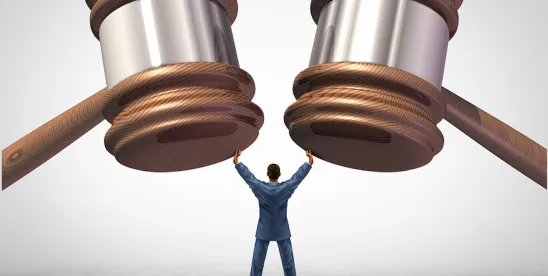Since the United States Supreme Court’s decision in Marbury v. Madison, 5 US 137 (1803), it has been the role of the federal judiciary to determine how federal statutes should be interpreted and applied. As the creation of administrative agencies rapidly expanded in the early 1900s, Congress enacted the Administrative Procedure Act (APA), which mandated that in legal challenges to an administrative agency’s action, the reviewing court shall decide all questions of law and statutory interpretation. 5 U.S.C. § 706. In Chevron, U.S.A., Inc. v. Nat. Res. Def. Council, 467 U.S. 837 (1984), the Court held that where a federal statute was silent or ambiguous with respect to the specific issue being litigated, the reviewing court was required to defer to the administrative agency’s statutory interpretation, even if the reviewing court would have reached a different conclusion based on its independent legal judgment. In Loper Bright Enters. v. Raimondo, 144 S. Ct. 2244, decided on June 28, 2024, a 6-3 majority of the Court overruled Chevron, holding that its deferential standard violated both Article III of the Constitution and the APA.
Loper Bright Ents. v. Raimondo
Loper Bright involved two legal challenges to the National Marine Fisheries Service’s (“NMFS”) agency actions interpreting the Magnuson-Stevens Fishery Conservation and Management Act (“MSA”). Specifically, commercial fisheries challenged the NMFS’s rule requiring that Atlantic herring fisheries pay the costs associated with having observers on their fishing vessels. The District Courts in both cases granted summary judgment to the government finding that the MSA’s interpretation was entitled to deference under Chevron. On appeal, both the D.C. Circuit and Eleventh Circuit affirmed the grant of summary judgment, holding that because the MSA provision at issue was ambiguous and the NMFS’s interpretation was reasonable, the NMFS’s interpretation of the relevant MSA provision was entitled to deference under Chevron. The Supreme Court granted certiorari in both cases.
The Court began its decision in Loper Bright by analyzing the historic role of the judiciary as it relates to deciding questions of law, including interpretation of federal statutes. The Court began with Article III of the Constitution, which exclusively assigns to the federal judiciary responsibility for adjudicating cases and controversies. The Court also noted that it has always been the framers’ intent, as established in Marbury v. Madison, for the courts to use their independent judgment free from political influence to interpret federal statutes and “say what the law is” to ascertain the rights of parties. It also explained that the courts have always recognized that the exercise of independent judicial judgment often included giving due consideration to the Executive Branch’s interpretation of federal statutes. But, while courts historically gave respect to the Executive Branch’s interpretations, they were not bound to adopt those views if they differed from the courts’ independent judgments.
As the creation of administrative agencies greatly expanded after the New Deal, the Court noted that the federal judiciary’s approach to legal issues initially did not change. While the courts treated an agency’s factual determinations as binding, they continued to exercise independent legal judgment in interpreting federal statutes, which included giving due weight to the interpretation adopted by the agency. In 1946, Congress enacted the APA, which directs that “[t]o the extent necessary to decision and when presented, the reviewing court shall decide all relevant questions of law, interpret constitutional and statutory provisions, and determine the meaning or applicability of the terms of an agency action.” The Court explained that the APA “codifie[d] for agency cases the unremarkable, yet elemental proposition reflected by judicial practice dating back to Marbury; that courts decide legal questions by applying their own judgment.” From the enactment of the APA in 1946 until 1984, the Court noted that “courts generally continued to review agency interpretations of the statutes they administer by independently examining each statute to determine its meaning.”
All of that drastically changed when the Court issued the Chevron decision in 1984. Chevron, which was decided by a six-member quorum, “triggered a marked departure from the traditional approach” to judicial consideration of administrative agencies’ statutory interpretations. In Chevron, the Court addressed a challenge to the Environmental Protection Agency’s interpretation of the Clean Air Act. In addressing that question, the Court adopted a new two-step approach to judicial review of an agency’s action. First, the court had to determine whether Congress had directly spoken to the precise question at issue. If Congressional intent was clear, the court was to reject the agency’s interpretation if it was contrary to clear Congressional intent. If Congressional intent was lacking or ambiguous, the court was to employ the second step, which required the court to defer to the agency’s interpretation if it offered “a permissible construction of the statute,” even if it was “not the reading the court would have reached if the question initially had risen in a judicial proceeding.” The Court’s decision in Chevron was premised on a host of policy and other considerations that the executive branch’s interpretation was entitled to judicial deference. As the Court remarked in Smiley v. Citibank (South Dakota), N.A., 517 U.S. 735, 740-41 (1996), “Chevron rested on a presumption that Congress, when it left an ambiguity in a statute meant for implementation by an agency, understood that the ambiguity would be resolved, first and foremost, by the agency, and desired the agency (rather than the courts) to possess whatever degree of discretion the ambiguity allows.”
In Loper Bright, the Court viewed the legal challenges to the NMFS’s interpretation of the MSA as an opportunity to revisit the two-step deferential standard established in Chevron. The Court began by noting that Chevron’s deferential standard “defie[d] the command of the APA” that the court and not the agency is to decide all relevant questions of law and statutory interpretation. The Court explained that the Chevron deference standard required courts to ignore, rather than follow their own independent legal judgment as required by the APA. The Court held that while the reviewing court’s independent judgment should include due consideration of the agency’s interpretation, the Chevron standard was legally flawed because it demanded “binding deference” to agency determinations in violation of the APA and Article III of the Constitution.
The Court also explained that because statutory ambiguities were not unique to statutes that delegate authority to administrative agencies, there was no legitimate reason to presume that Congress intended statutory ambiguities to be reconciled solely by administrative agencies. The Court noted that statutory ambiguities are commonplace, and courts are well-equipped and have “special competence in resolving statutory ambiguities.” The Court reasoned that Chevron was “misguided” to the extent that binding deference was premised on the belief that administrative agencies are better equipped to resolve statutory ambiguities, especially given that administrative agencies and their statutory interpretations can shift based on political changes.
In overruling Chevron, the Court rejected the government’s and dissent’s arguments that deference to administrative agencies was justified. First, the Court rejected the government’s argument that administrative agencies have subject matter expertise to interpret statutes that often involve highly technical matters. The Court explained that the subject matter argument did not hold weight because the deference required by Chevron applied to all agency determinations, even those that did not involve areas of agency expertise. Second, the Court observed that reviewing courts are frequently asked to “handle technical statutory questions” and “do not decide such questions blindly,” and often have the technical expertise of the parties, amici, and the administrative agency’s interpretation to consider in making an informed judgment without having to be bound by the agency’s interpretation. The Court also rejected the government’s argument that interpretation of an ambiguous statute requires “policymaking suited for political actors rather than courts.” The Court reasoned that the resolution of statutory ambiguities involves legal interpretation that is best handled by a court, and while policymaking is best handled by political actors, statutory interpretation should be free from political influence.
The only significant question the Court faced was whether stare decisis was a sufficient reason to avoid overruling Chevron. Ultimately, the Court determined that it was not. First, the Court noted that over the forty years since Chevron was decided, the Court had imposed so many limitations on its application that its utility was no longer apparent. For example, Chevron’s deferential standard only applied where: (1) it was clear that Congress had delegated particular authority to an agency; (2) Congress delegated authority to the agency to make rules carrying the force of law and the agency’s action was an exercise of that authority; (3) the agency’s action was not procedurally defective; and (4) there was no deep economic or political significance to the agency’s decision. The Court further noted that many lower courts struggled with applying Chevron and its nuances, preconditions, and exceptions, and that the Court itself had not deferred to an agency interpretation since 2016. By way of example, the Court noted that Chevron’s first step, whether Congressional intent was ambiguous, created more questions and issues than it solved. Ultimately, the Court determined that Chevron’s unworkability, fundamentally flawed foundation, and conflict with the well-established role of the judiciary in interpreting statutes and deciding legal issues, mandated that Chevron be overruled. As the Court explained, “Chevron has thus become an impediment, rather than an aid, to accomplishing the basic judicial task of saying what the law is.” The Court held that courts must exercise their independent judgment in deciding whether an agency has acted within its statutory authority, while paying careful attention to the judgment of the Executive Branch in conducting that inquiry. Courts may no longer “defer to an agency interpretation of the law simply because a statute is ambiguous.”
In overruling Chevron, the Court declared that its decision did not call into question any prior decisions that relied on the Chevron framework, and those decisions were still bound by stare decisis principles. The Court remanded the underlying cases back to the circuit courts for an independent judicial interpretation of the applicable statutory provision.
Justices Thomas and Gorsuch issued separate concurring opinions joining in the decision to overrule Chevron. Justice Thomas wrote separately because he viewed the Chevron deference standard as violative of the separation of powers. Justice Gorsuch wrote separately to express his additional views that Chevron is not entitled to maintain its precedential status under stare decisis principles. Justices Kagan, Sotomayor, and Jackson dissented from the Court’s decision. The dissent argued that because administrative agencies had particular subject matter expertise in the pertinent statutes they administered, and because Congress would want statutory ambiguities to first be addressed by the agencies designated to administer the statutes, Chevron’s deferential standard provided a workable framework for adjudicating disputes for forty years. In light of these considerations, the dissent asserted that principles of stare decisis required that Chevron not be overruled.
What This Case Means
The Loper Bright decision represents a significant shift in the balance of powers between the executive and judicial branches. Since Chevron was decided in 1984, the executive branch, and specifically administrative agencies, had significant say in how ambiguous statutes that affect almost every aspect of America were interpreted and applied. Now, that power has been shifted almost exclusively to judges who, clearly have the legal knowledge and experience to perform a statutory interpretation, but may lack the subject matter expertise to interpret and apply statutes in highly technical areas like drugs and medical devices, environmental protection, and transportation safety. While the Loper Bright decision acknowledges that courts should still afford due weight to an agency’s interpretation and view of a particular statute it has been delegated to execute, the decision makes clear that courts must exercise their own independent judgment in determining the legal issues presented.





 />i
/>i

